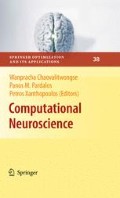Abstract
Among the various frameworks in which EEG signal analysis has been traditionally formulated, the most widely studied is employing power spectrum measures as functions of certain brain pathologies or increased cerebral engagement. Such measures may form signal features capable of characterizing and differentiating the underlying neural activity. The objective of this chapter is to validate the use of wavelets in extracting such features in the time–scale domain and evaluate them in a simulated environment assuming two tasks (control and target) that resemble widely used scenarios of assessing and quantifying complex cognitive functions or pathologies. The motivation for this work stems from the ability of time–frequency features to encapsulate significant power alteration of EEG in time, thus characterizing the brain response in terms of both spectral and temporal activation. In the presented algorithmic scenario, brain areas’ electrodes of significant activation during the target task are extracted using time-averaged wavelet power spectrum estimation. Then, a refinement step makes use of statistical significance-based criteria for comparing wavelet power spectra between the target task and the control condition. The results indicate the ability of the proposed methodological framework to correctly identify and select the most prominent channels in terms of “activity encapsulation,” which are thought to be the most significant ones.
Access this chapter
Tax calculation will be finalised at checkout
Purchases are for personal use only
References
Bianchi, A., Mainardi, L., Cerutti, S. Time-frequency analysis of biomedical signals. Trans Inst Measur. and Contr 22, 321–336 (2000)
Breakspear, M., Terry, J., Friston, K., Harris, A., Williams, L., Brown, K., Brennan, J., Gordon, E. A disturbance of nonlinear interdependence in scalp EEG of subjects with first episode schizophrenia. NeuroImage 20, 466–478 (2003)
Bressler, S. The Handbook of Brain Theory and Neural Networks. MIT Press, Cambridge MA 412–415, (2002)
Bruns, A. Fourier-, Hilbert- and wavelet-based signal analysis: Are they really different approaches? J Neurosci Methods 137(2), 321–332 (2004)
Burrus, S., Gopinoth, R., Haitao, G. Introduction to Wavelets and Wavelet Transforms. Prentice Hall Inc., Upper Saddle River, NJ (1998)
Chatfield, C. The Analysis of Time Series: An Introduction, 4th edn, p. 241. Chapman and Hall, London (1989)
Dumermuth, G., Molinari, L. Spectral analysis of the EEG. Some fundamentals revisited and some open problems. Neuropsychobiology 17, 85–99 (1987)
Farge, M.: Wavelet transforms and their applications to turbulence. Annu Rev Fluid Mech 24, 395–457 (1992)
Kalayci, T., Ozdamar, O. Wavelet preprocessing for automated neural network detection of EEG spikes. IEEE Eng Med Biol Mag 14, 160–166 (1995)
Meyers, S., Kelly, B., O'Brien, J. An introduction to wavelet analysis in oceanography and meteorology: With application to the dispersion of Yanai waves. Mon Wea Rev 121, 2858–2866 (1993)
Micheloyannis, S., Sakkalis, V., Vourkas, M., Stam, C., Simos, P. Neural networks involved in mathematical thinking: Evidence from linear and non-linear analysis of electroencephalographic activity. Neurosci Lett 373, 212–217 (2005)
Raudys, S., Pikelis, V. On dimensionality, sample size, classification error and complexity of classification algorithm in pattern recognition. IEEE Trans Pattern Anal Machine Intell, PAMI-2(3), 242–252 (1980)
Sakkalis, V., Giurcaneanu, C., Xanthopoulos, P., Zervakis, M., Tsiaras, V., Yang, Y., Micheloyannis, S. Assessment of linear and nonlinear synchronization measures for analyzing EEG in a mild epileptic paradigm. Accepted to be published in, 2008. IEEE Trans Inf Tech (2008). DOI: 10.1109/TITB.2008.923141.
Sakkalis, V., Zervakis, M., Micheloyannis, S. Significant EEG features involved in mathematical reasoning: Evidence from wavelet analysis. Brain Topogr 19(1–2), 53–60 (2006)
Simos, P., Papanikolaou, E., Sakkalis, E., Micheloyannis, S. Modulation of gamma-band spectral power by cognitive task complexity. Brain Topogr 14, 191–196 (2002)
Stoica, P., Moses, R. Introduction to Spectral Analysis. Prentice-Hall, Upper Saddle River, NJ (1997). 24–26
Torrence, C., Compo, G. A practical guide to wavelet analysis. Bull Am Meteorol Soc 79, 61–78 (1998)
Weiss, S., Mueller, H. The contribution of EEG coherence to the investigation of language. Brain Lang 85, 325–343 (2003)
Zar, J.: Biostatistical Analysis, 4th edn. Prentice Hall, Upper Saddle River, NJ (1999)
Acknowledgements
This work was supported in part by the EU IST project BIOPATTERN, Contact No: 508803. The Wavelet Transform and various significance testing parts were performed using software implementation based on the wavelet toolbox provided by C. Torrence and G. Compo, available at the URL: http://paos.colorado.edu/ research/ wavelets/.
Author information
Authors and Affiliations
Corresponding authors
Editor information
Editors and Affiliations
Rights and permissions
Copyright information
© 2010 Springer Science+Business Media, LLC
About this chapter
Cite this chapter
Sakkalis, V., Zervakis, M. (2010). Methodological Framework for EEG Feature Selection Based on Spectral and Temporal Profiles. In: Chaovalitwongse, W., Pardalos, P., Xanthopoulos, P. (eds) Computational Neuroscience. Springer Optimization and Its Applications(), vol 38. Springer, New York, NY. https://doi.org/10.1007/978-0-387-88630-5_3
Download citation
DOI: https://doi.org/10.1007/978-0-387-88630-5_3
Published:
Publisher Name: Springer, New York, NY
Print ISBN: 978-0-387-88629-9
Online ISBN: 978-0-387-88630-5
eBook Packages: Mathematics and StatisticsMathematics and Statistics (R0)

